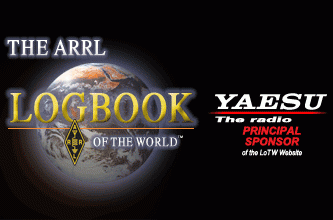Trusted QSL V2.6 Released
TQSL is free software used to upload and sign logs to the ARRL Logbook of the World (LoTW). TQSL works with Windows, MacOS and Linux. LoTW is free to all Amateur Radio Operators around the world, and membership in the ARRL is not required to use LoTW.
The latest version of TQSL can be downloaded from the ARRL website.
Trusted QSL V2.6 Release Notes
This version of Trusted QSL (TQSL) has new features as well as corrections for defects found since TQSL 2.5.9 was released.
Updates since TQSL 2.5.9:
This release includes an update to the most recent TQSL configuration file.
There were no serious defects reported for TQSL 2.5.9. This release contains several minor updates which have accumulated since 2.5.9.
TQSL 2.6 can be installed to upgrade any older version of TQSL.
For the Mac platform, TQSL now uses a package file (.pkg) for installing TQSL. This is hopefully easier to use as it is a familiar way to install software for most Mac users.
On all three supported platforms (Windows, MacOS, and Linux), installing TQSL 2.6 will replace older versions of Trusted QSL while preserving your Callsign Certificates, Station Locations, and preferences. On Windows, simply run the TQSL 2.6 installer, which will automatically uninstall older versions of TQSL (and, if installed, TQSLCert). On Mac OS X, open the package (.pkg) file to install TQSL into your Applications folder. (Note that the “tqsl-legacy” package is for legacy Mac systems – 32 bit Intel and PowerPC.) Direct the installer to “Replace All”, which will uninstall old files. For Linux systems, unpack the tar file and read the INSTALL file for directions.
TQSL 2.6 has been “localized” to allow use in the native language of non-English speakers. This could not have been done without the help of the volunteers who have contributed translations for TQSL. Thanks to the following for their assistance:
The following list describes the major changes in the v2.6 release of Trusted QSL.
TQSL changes
Defects Corrected:
When signing a log, TQSL verifies that the Callsign Certificate is still valid before signing. This keeps the situation where the callsign certificate has just expired from causing an uploaded log to fail.
When a location has only one possible value for CQ or ITU zones, choose the related zone and don’t let that zone be changed. This corrects cases where operators “know” that the wrong values for their zones.
For some callsign certificates which were pending ARRL approval, TQSL could hang when displaying the properties. TQSL now displays these properly.
A replaced Callsign Certificate (one which has been replaced with a later version) can no longer be used to renew that Callsign Certificate. If the latest Callsign Certificate for a given call is not available, then the Callsign Certificate can’t be renewed and must be requested as if it is a new Callsign Certificate.
Major feature Additions:
TQSL no longer asks what a Callsign Certificate request is for (primary station, secondary call, older call, club, etc.) as this doesn’t really explain why this information was being used or what it was being used for.
The purpose of this was to allow TQSL to determine if the QSOs for the new callsign should be stored in the same Logbook of the World account (decided by the callsign used to log in) as some other callsign. Rather than guess, TQSL now asks if there’s an existing Logbook account and asks for a valid callsign certificate for that call to allow merging the new logs. For example, a new callsign certificate for a special event, like “W1AW/150” should go into the same Logbook account as “W1AW”. However, for a QSL manager, they likely want every callsign they’re maintaining logs for to go into a different Logbook account. Trying to guess this from a menu isn’t going to get it right, so the question is now more direct.
TQSL now allows command-line log signing to take place without any station location being defined. This requires the ADIF log to supply all of the QSO information – callsign and DXCC entity at the least, but can include other details such as zones, state/province, and county. For logging programs that emit full QSO data, this allows the logger to submit a single log for multiple callsigns and multiple locations. Logbook will properly assign QTH and callsign credit for all of the included QSOs.
The Station Location dialog was redesigned so it’s one page, with a QSL card appearance. This allows immediate detection of bad settings like CQ/ITU zones on the single page, and handles changes of callsigns with multiple related entities (for example, a call in continental US and Alaska).
The display of Station Location properties was updated to use the same page layout as the definition page. This detailed “QSL card” format is hopefully less confusing.
The Callsign Certificate status tab in TQSL now breaks down the list of certificates into named categories, so expired, replaced, or pending callsign certificates are all easier to spot (and no longer depend on obscure icons to indicate what state a particular callsign has.)
Minor Updates:
Added support for several new Cabrillo “bands” for 2 and 2.5 mm.
Rebuilt the TQSLlib application programming interface (API) documentation so it does not use an outdated version of jquery. This stops spurious antivirus warnings on Linux systems.
Added a new log-handling preference to allow the seconds in QSO times to be ignored. This makes it easier to reject multiple close-together QSLs from WSJT-X.
When opening a Callsign Certificate file, both P12 and TQ6 files are selected.
Reinstalling TQSL 2.5.9
Downgrading to TQSL 2.5.9 can be seamlessly performed by uninstalling TQSL 2.6 and reinstalling TQSL 2.5.9.

